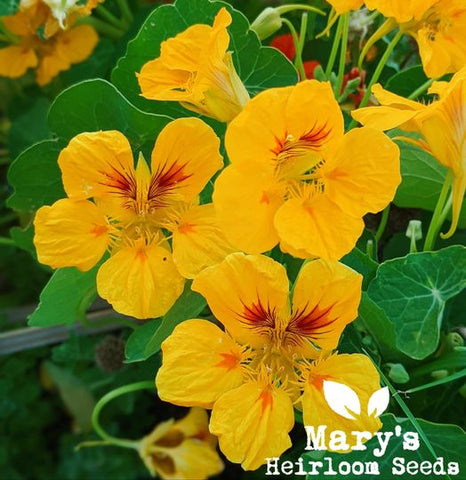One of the best things about wildflowers is how easy they are to grow! In case you missed it, we recently posted an article of EDIBLE FLOWERS at Mary's Heirloom Seeds!
Plan
Check for your last frost date and plant after this has passed.
Choose a spot on your property that gets 6 or more hours of direct sun a day.
Prepare your soil be clearing the area of all existing growth. Simply dig up everything that is growing, turn the soil and rake the area flat. If this is an area that has never before been gardened, you may need to till the area up to remove growth.
Plant
Mix the seeds with sand for better visibilty and scatter the seeds directly on top of the soil.
We recommend lightly compressing the seeds into the soil, making sure not to bury them. You can either walk on them, use a board or just pat down with you hands.
Grow
Water so that the soil is moist, not soaking wet, until the seedlings are about 4-6" tall. After that, the seedlings will survive on natural rains. If you are experiencing very dry weather, we recommend watering occasionally.

Spring, summer and fall are all wildflower planting times, depending on your region, your weather, and the way you want to approach establishing your meadow. No matter when or where you plant, site preparation is roughly the same. But the first consideration is not the season; it's your climate.
For mild-winter areas: If you're planting in a warm place such as California, Florida or southern Texas, with minimal — or no — winter frost, you can plant almost anytime, except during your hottest season. Best time is just before your rainiest season begins, and when you know the weather will not be too hot for young seedlings. In Florida, fall is best. In California, most wildflowers are planted during the winter to take advantage of California's greening in early spring.
For all areas with killing frost: If you have definite killing frost in winter, things are different. In these areas (most of the country) spring and fall are both fine for planting, and each has its advantages.
Wildflowers can re-seed and continue to grow for many years if planted in an area that will allow them to flourish. Saving seeds from these wildflowers is easy and will ensure flowers for the future.

Companion Planting with Flowers
Companion planting is based around the idea that certain plants can benefit others when planted next to, or close to one another.
Companion planting exists to benefit certain plants by giving them pest control, naturally without the need to use chemicals, and in some cases they can give a higher crop yield.
Marigolds: Basil, broccoli, cabbage, cucumbers, eggplant, gourds, kale, potatoes, squash and tomatoes. Often called the "workhorse" of pest deterrents.
Bachelor Button: Attracts pollinators to the garden
Lavender: cabbage, cauliflower and fruit trees
Nasturtium: cucumbers, melon, squash, cabbage, broccoli, tomatoes, celery, carrots and radish. Repels Carrot fly, Japanese beetle, whitefly, aphid and cabbage moth.
Sunflower: Corn, squash and beans. Attracts pollinators to the garden.
Lupine: nitrogen rich. Attracts pollinators. Traps aphids!
Echinacea and Yarrow: Attracts pollinators to the garden. *Also reported to have medicinal properties*
More great companions include:

I hope you have enjoyed another educational article.



1 comment
I started some companion planting last year and am doing more this season, but a field of wildflowers sounds like project with multiple perks.